 |
October 2012
|
October 2012 // Volume 50 // Number 5 // Tools of the Trade // v50-5tt2
Consumer-Centered Extension Education Website Increases Usage
Abstract
Concern about young families' ability to cope with rising food prices resulted in creating Spend Smart. Eat Smart (SSES), a website focused on budget-friendly nutrition information for limited resource audiences (LRA). SSES was redesigned using LRAs needs and preferences to increase use by LRAs. SSES usage increased after it was revised to incorporate interactivity and more consumer-friendly design elements.
Introduction
Spend Smart, Eat Smart (SSES) http://www.extension.iastate.edu/foodsavings, a unique website providing budget-friendly nutrition information for limited resource audiences (LRA), was developed for LRAs ages 18-40 years. When 6-month usage data indicated most SSES viewers were not this demographic, website revision was undertaken. Social marketing theory (SMT) principals guided the revision process by addressing the identified needs and preference assessments of LRAs ages 25-40 years (Francis, Martin, & Taylor, 2011)
SMT is used to direct health program development because the target audience is involved throughout the process (Lefebvre & Rochlin, 1997). SMT is a cyclic process made up of six steps: 1) planning and strategy, 2) selecting channels and materials, 3) developing materials and pretesting, 4) implementation, 5) assessing effectiveness, and 6) using feedback to revise the program (1). Each step is needed in producing effective client-centered curriculum. The data presented here address SMT Step 5 (assessing effectiveness).
Methods
Effectiveness of the website revisions was assessed through online lesson participation, polling responses, and usage data tracked by WebTrends, a tool that does not allow the collection of sociodemographic information. This project was IRB exempt.
Description of SSES Revisions
SSES originally consisted of primarily print-style education materials accessible through an online format with less prominent search tabs placed at top (Figures 1a-1d). SSES was redesigned targeting LRAs age 25-40 and incorporating interactivity and more consumer-friendly design elements. Basic changes included a creative use of color and graphics, including a new logo. Additionally, the homepage was redesigned to encourage viewer participation in SSES social media endeavors like the SSES blog (previous blog posts appear on the homepage), Facebook, Twitter, and Ask an Expert. Each of these social media outlets conveys similar messages promoting eating well on a budget.
Figure 1a.
Original SSES Homepage
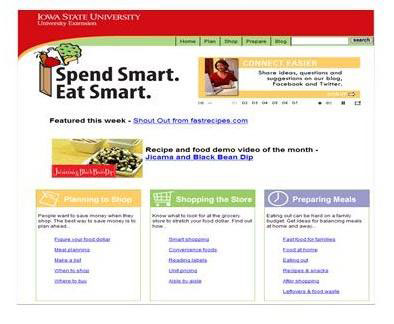
Figure 1b.
Revised SSES Homepage
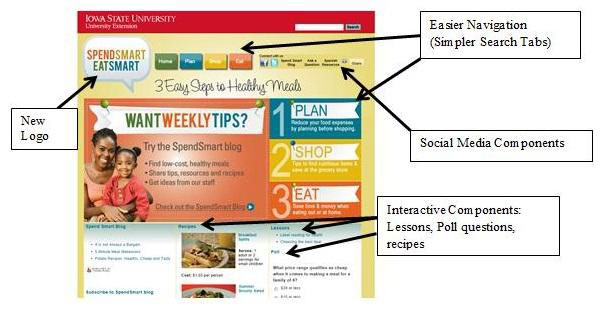
Figure 1c.
Original SSES Content Page
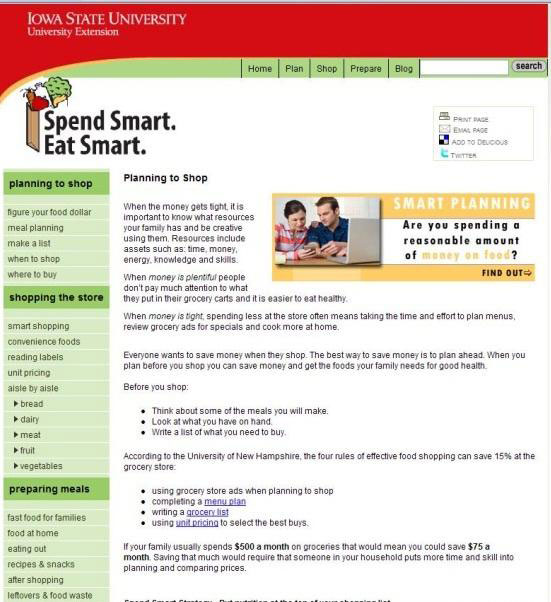
Figure 1d.
Revised SSES Content Page
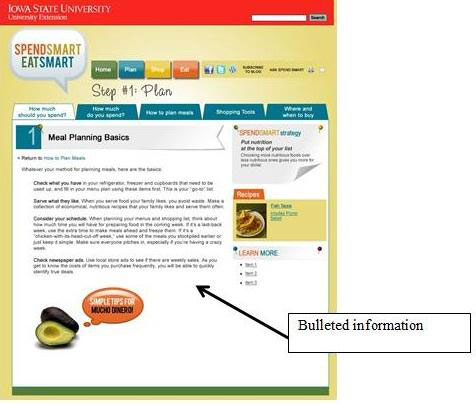
Ease of navigation, an identified need and preference, was addressed by using:
- More bulleted information
- Concise search tabs across the top and the right-hand side
- Embedded flash video on the homepage emphasizing the three search tabs: plan, shop, eat.
These words (plan, shop, eat) convey the identified learning needs of LRAs, including how to: save money, make healthy food choices, and prepare food. "Plan" includes budgeting, menu planning, and other shopping tools. "Shop" provides information such as aisle-by-aisle tips, unit cost, and label reading. Finally, "Eat" offers information for organizing the kitchen, healthy cooking, and recipes.
SSES interaction was promoted through online lessons, polls, and recipes. Two lessons were created using a voice-over format in PowerPoint targeting the two leading identified nutrition topics of interest, label reading and unit cost. Both topics were placed under the heading "Shop." Lesson interaction was measured with the number of viewers as well as the number of viewers who completed at least one quiz question. Polling questions were also added to encourage interaction. The chosen questions were designed to provide the EFNEP/FNP director information regarding food purchasing, eating practices, and nutrition information of viewers, which were then addressed later in the weekly SSES blog. Polling questions are changed bi-monthly.
Additionally, during the needs and preference assessment LRAs requested recipes with nutrition information and wanted the ability to provide feedback (Francis, Martin, & Taylor, 2011). The original SSES provided recipes that were selected based on cost, nutritional value, and preparation time. The revised SSES includes these original recipe components but made the recipe portion more interactive. Under the "Eat" section, short cooking demonstration videos were added for select recipes. Additionally, WordPress with a recipe plug-in, was chosen as the recipe interface because it allowed viewers an opportunity to comment on the recipes. Each recipe has a nutrition facts label included.
Results
Recruiting
SSES launched in February 2009. Viewing statistics from August 2009 to July 2010 indicated about 74,334 visits and increased to 87,278 after the revised SSES launched (August 2010-July 2011); these numbers do not distinguish between first-time or repeat viewers (Figure 2a). Similarly, as shown in Figure 2b, the number of blog subscribers increased from July 2010 (1,255 subscribers) to July 2011 (1,818 subscribers). Traditional print materials (posters with tear-off recipe cards and/or QR codes and flyers) continue to be used to promote SSES because this was the preferred method reported by LRAs (Francis, Martin, & Taylor, 2011). Since the revision, marketing efforts have better targeted agencies serving LRAs (e.g., Food Assistance and WIC offices, etc.).
Figure 2a.
SSES Website Usage
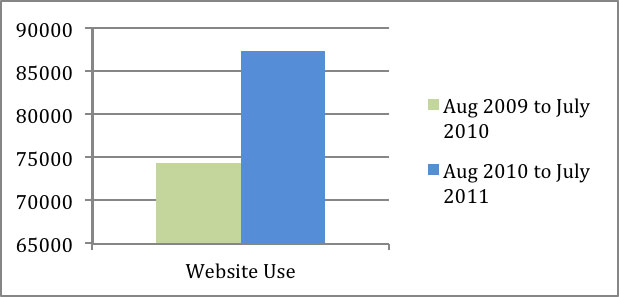
Figure 2b.
SSES Blog Usage

Usage
"Label Reading for Health" was viewed by 748 people, while "Choosing the Best Deal" (unit cost) was viewed by 885; however, only 231 people provided demographic information (Table 1). One hundred forty-eight (19.8%) label-reading viewers answered Question 1 (asked at the end), indicating the lesson was watched for 10 minutes. Two-hundred thirty-nine (27%) unit-cost viewers answered Question 1 (appeared throughout the lesson), indicating the lesson was watched for at least 2 minutes. Viewers correctly answered three out of six questions (50%) on the label-reading quiz and 9 out of 11 (82%) of the unit-cost questions.
Eight poll questions have been posted since August 2010, resulting in 1,247 votes. Some questions have included: 1. What grocery store do you shop at most often?, 2. What you think saves you the most money?, 3. What price range qualifies as "cheap" when it comes to making a meal for a family of four?
| Label Reading (N=117) | Unit Cost (N=114) | |
|
Gender Male Female |
5 (4.3%) 112 (95.7%) |
24 (21.1%) 90 (78.9%) |
| < 40 years old | 40 (34.2%) | 54 (47.0%) |
| EFNEP/FNP Eligible | 34 (29%) | 54 (27%) |
| a Total viewers reporting demographic information was 231 | ||
Summary and Implications for Extension
Recruiting and usage data do suggest the revised SSES is being used more frequently than the original SSES. However, the limited number of viewers providing sociodemographic information through the online quizzes makes it difficult to ascertain if SSES is being used by the target audience. This was anticipated because the needs and preference assessment discovered LRAs are not comfortable providing sociodemographic information online.
Additionally, online lesson participation indicates this form of education is well-received, suggesting this as a potential Extension educational strategy. When developing an Extension education website, following the below suggestions may lead to higher participation and better results.
- Involve the target audience throughout the development process.
- Create a layout that is searchable and visually appealing.
- Incorporate interactive features and social media components.
- Develop online lessons that are relevant and of interest to the target audience and the include quiz questions throughout.
References
Francis, S., Martin, P, & Taylor, K. (2011). Revising an Extension education website for limited resource audiences using social marketing theory. Journal of Extension [On-line], 49(6) Article 6FEA7. Available at: https://www.joe.org/joe/2011december/a7.php
Lefebvre, R. C., & Rochlin, L. (1997). Social marketing. In K. Glanz, F. M. Lewis, & B. K. Rimer (Eds), Health behavior and health education (Second ed., pp. 384-402), San Francisco, CA: Jossey-Bass Publishers.




